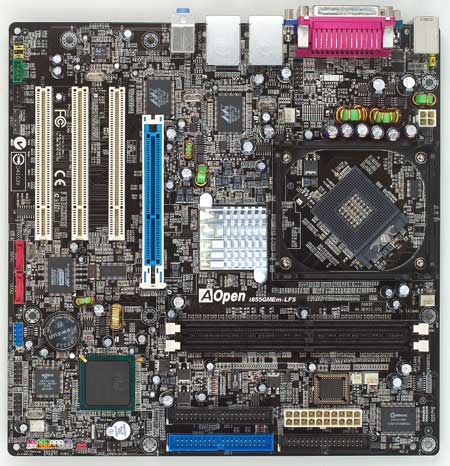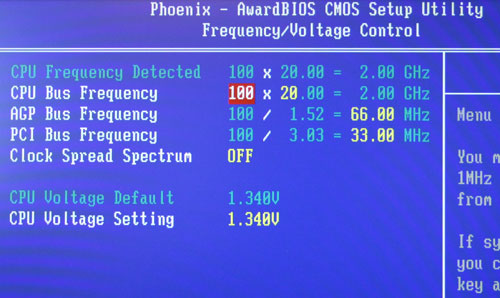Intel's Pentium M on the Desktop - A Viable Alternative?
by Anand Lal Shimpi on February 7, 2005 4:00 PM EST- Posted in
- CPUs
The Motherboards
As we mentioned before, both AOpen and DFI are currently shipping Pentium M desktop micro ATX motherboards based on Intel's 855GME chipset.AOpen
The AOpen GMEm-LFS is a micro ATX board based on the 855GME chipset, with integrated graphics support as provided by the chipset.
AOpen outfitted the board with dual GigE ports, both of which are placed on the back I/O panel above the four USB 2.0 ports.
The board only requires a 20-pin ATX power connector and a 4-pin +12V auxiliary connector like older Pentium 4 motherboards, although you can use a newer 24-pin PSU if you'd like.
Since AOpen uses ICH4-M, only parallel ATA is supported, so AOpen outfitted the board with a Promise SATA RAID controller to drive the two SATA ports on the board. AOpen also placed an Agere FireWire 400 controller on the board; however, they didn't supply the bracket to actually take advantage of the two ports supported by the controller.
The BIOS setup of the GMEm-LFS is pretty straightforward, although we definitely appreciated the layout of the overclocking options. The only complaint we had was that memory dividers weren't explicitly listed, which requires some math on the user's part to make sure that they're selecting the right memory speed when overclocking. The only voltage adjustments present on the board are for Vcore, which unfortunately tops out at 1.340V.

We had pretty decent overclocking success with the AOpen board and our Pentium M 755 (2.0GHz). Running it at 133MHz (533MHz FSB) x 18 at the maximum core voltage of 1.340V proved to be quite stable in all of our benchmarks. We could get the Pentium M to POST at 2.53GHz, but it wasn't stable enough to run our benchmarks.
Unfortunately, the biggest problem with overclocking the AOpen (as well as the DFI) board was that you could hardly overclock the memory bus. Regardless of what type of DDR400 memory we used, the highest that we could get the memory bus to run (stable) was 355MHz using the 4:3 memory divider.
Given how bandwidth-starved the Pentium M is, we were hoping for better overclocking success in the memory department, but were met with disappointment. The problem appears to be related to the 855GME chipset, as the DFI board suffered the same fate as the AOpen board.
So, while there's headroom in the CPUs (even our 1.7GHz Pentium Ms had no problems running above 2.0GHz), it seems like the chipsets/motherboards will limit the extent to which you can overclock.
The AOpen GMEm-LFS currently sells for $230.










77 Comments
View All Comments
Lupine - Wednesday, February 16, 2005 - link
I'm surprised at these results. I'm setting up a new Dell Inspiron 9200 (M 725 @ 1.6GHz/400MHz FSB) and it is schooling both my Barton 2500+ @ 2.2GHz and TBred B 1700+ @ 2.2GHz running Stanford's Folding@Home project (600 point proteins: ~37min per frame for the XP boxes compared to ~34min per frame w/ the laptop).So, if it is so weak, what is allowing it to process WUs at such a competitive rate? Sure, that is slower than an A64, but competitive w/ most P4 procs.
fitten - Thursday, February 10, 2005 - link
Something else to remember about the Banias/Dothan line of chips... Agressive power reduction was the #1 goal of the design process. In a 'normal' chip design, not all pipeline stages are the same length, the clock speed it runs at is the speed of the slowest part of the CPU. Since power usage is directly related to the frequency of the switching gates, the Intel engineers actually deliberately slowed down some parts of the chip to match the target release speeds (or get close to them) to reduce power consumption. This is, perhaps, the main reason why the frequencies don't scale so well as some would want them to scale.Visual - Thursday, February 10, 2005 - link
here's another thought... when the opterons launched initially at ECC DDR266, there were similar comments like "give it unbuffered DDR400 or higher and stay out of its way" :) well, now that we have that, ok it did improve performance a bit. but not hugely. shouldn't help the dothan significantly more too.Visual - Thursday, February 10, 2005 - link
I like how AMD got beaten by the P-M :) not because im intel fan, just because this will make things more interesting now.don't catch flame from this comment :p its my oppinion
Funny how you picked the game benchmarks btw, its almost as if you wanted to show the P-M lacking behind the A64... from what I've seen it beats A64 in HL2 and CSS, and that's a game you don't skip usually :) so why now?
Also looks suspicious how in lots of tests where P-M performs well with the A64 clock-for-clock or beats it, there is almost no difference in the 3800+ and 4000+ results... like if L2 isnt all that important, yet L2 is exactly how everyone explains the P-M success
Maybe we'll see some 2MB L2 A64 "emergency edition" once Dothan gets a decent desktop chipset, just like what intel did to (try to) save P4 from the A64 :)
actually i'd be happy if Dothan motivates AMD to develop faster L2 cache or something.
Knowing Intel, i dont expect they'd even try to match AMD's prices with the P-M... and there's a lot of room for AMD to decreace prices, as they're selling with quite a margin now. So for sure the P-M won't be cost-effective compared to A64, not if you don't care for ultra-low power consumption at least.
also it doesn't look likely Dothan could scale beyond 2.6GHz on current 90nm tech. by the time it gets there, AMD should've launched the 2.8 FX and most likely 3GHz too. so I have no doubts AMD will keep the lead for quite a while... maybe the race to 65nm will be the next turning point, as it seems its going smooth for intel (at least for P-M)
anyway, even if AMD is better in absolute performance, pricepoint and (arguably) clock-for-clock, you gotta admit it to the P-M, it does quite a punch. fun times are coming :)
Zebo - Wednesday, February 9, 2005 - link
dobwal buy intel if you want mhz, AMD is for performance.dobwal - Wednesday, February 9, 2005 - link
i wasn't referring to the FX series. Plus you are not understanding the point i was trying to make. Lets take a look at the FX series.OPN Model Operating Freq. Package ADAFX55DEI5AS FX55 2600MHz 939-Pin
ADAFX53DEP5AS FX53 2400MHz 939-Pin
ADAFX53CEP5AT FX53 2400MHz 940-Pin
ADAFX51CEP5AT FX51 2200MHz 940-Pin
ADAFX51CEP5AK FX51 2200MHz 940-Pin
the first FX51 was release around late third quarter 2003. So in a little over a year the FX series has only increased 400 Mhz. Can you automatically assume that the FX has poor scalability in terms of cpu speed. NO. You know why, because the EE is underperforming and can't touch the FX. AMD has no need to push large scale speed increases out of the FX line, which would do nothing but increase cost with each new stepping it used to boost performance.
The same goes for the Dothan at 2.26Ghz by the end of 2005. What other cpu offers the same level of performance vs. battery life. So why push for performance except to push sales.
You simply can't determine the scalabiltiy of a cpu based on its roadmap especially when its the performance leader in its market segment and has no current viable competitor or one in the near future.
Aileur - Wednesday, February 9, 2005 - link
Oh and, superpi relies on the fpu to do its calculations, so so much for this fpu is crap trend we have going here.http://mod.vr-zone.com.sg/Aopen_i855_review/25sPIm...
Aileur - Wednesday, February 9, 2005 - link
Oh and before you start bragging about the better superpi1mb result of the a64http://www.akiba-pc.com/DFI_855/d17g_2608_spi1m.gi...
this is 1 sec better, with 100mhz less, and single channel ram.
Aileur - Wednesday, February 9, 2005 - link
Since you seem to like xtremesystemshttp://www.akiba-pc.com/DFI_855/d15g_2435_spi1m.PN...
also a 1ghz overclock, also on default voltage
Id like to see how an a64 would perform on a kt266 (if that were possible)
Give the pentium m time to mature and all those "OMG HAHA YOU CPUZ IS SO HOT LOLOL!!!1111" will be obsoleet.
Zebo - Wednesday, February 9, 2005 - link
58 "How long has A64 been stuck on 2.4Ghz."----------------------------------
There not. 2.6 FX-55 been out for months. More importantly AMD does'nt have to release new chips the way they dominate the benchmarks now. Could they? Hell ya.They got a nice buffer going, New FX's hit 3.0 on stock air. Cheap 90nm's are now hitting 2.7 on default Vcore and air. And by air I mean AMD's cheap all aluminum HS with a itty bitty 15mmx70mm fan, not Prescotts copper core screamers.
T8000- You're clueless. Maybe it's the heat generated by your prescott making your head woozy, I dunno, but have a look here..1800 Mhz to 2800 Mhz on default Vcore stock fan.
http://www.xtremesystems.org/forums/showthread.php...